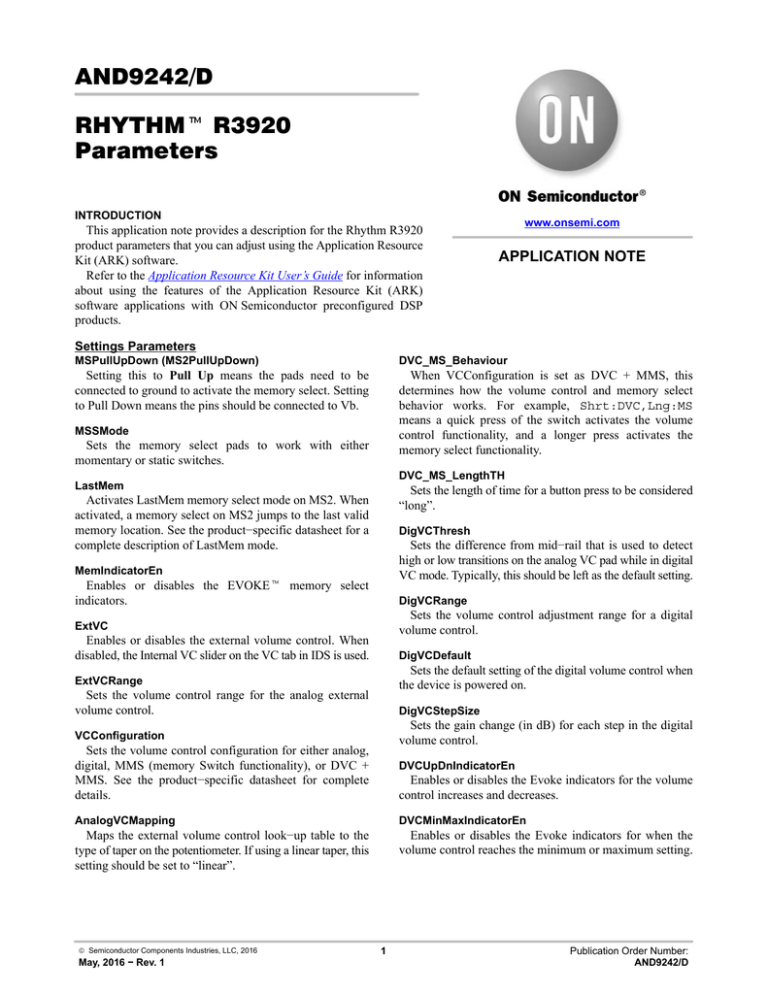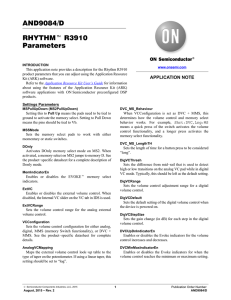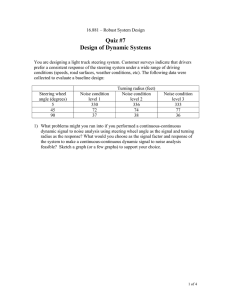RHYTHM R3920 Parameters
advertisement

AND9242/D RHYTHMt R3920 Parameters INTRODUCTION This application note provides a description for the Rhythm R3920 product parameters that you can adjust using the Application Resource Kit (ARK) software. Refer to the Application Resource Kit User’s Guide for information about using the features of the Application Resource Kit (ARK) software applications with ON Semiconductor preconfigured DSP products. www.onsemi.com APPLICATION NOTE Settings Parameters MSPullUpDown (MS2PullUpDown) DVC_MS_Behaviour Setting this to Pull Up means the pads need to be connected to ground to activate the memory select. Setting to Pull Down means the pins should be connected to Vb. When VCConfiguration is set as DVC + MMS, this determines how the volume control and memory select behavior works. For example, Shrt:DVC,Lng:MS means a quick press of the switch activates the volume control functionality, and a longer press activates the memory select functionality. MSSMode Sets the memory select pads to work with either momentary or static switches. DVC_MS_LengthTH LastMem Sets the length of time for a button press to be considered “long”. Activates LastMem memory select mode on MS2. When activated, a memory select on MS2 jumps to the last valid memory location. See the product−specific datasheet for a complete description of LastMem mode. DigVCThresh Sets the difference from mid−rail that is used to detect high or low transitions on the analog VC pad while in digital VC mode. Typically, this should be left as the default setting. MemIndicatorEn Enables or disables the EVOKEt memory select indicators. DigVCRange ExtVC Sets the volume control adjustment range for a digital volume control. Enables or disables the external volume control. When disabled, the Internal VC slider on the VC tab in IDS is used. DigVCDefault ExtVCRange Sets the default setting of the digital volume control when the device is powered on. Sets the volume control range for the analog external volume control. DigVCStepSize VCConfiguration Sets the gain change (in dB) for each step in the digital volume control. Sets the volume control configuration for either analog, digital, MMS (memory Switch functionality), or DVC + MMS. See the product−specific datasheet for complete details. DVCUpDnIndicatorEn Enables or disables the Evoke indicators for the volume control increases and decreases. AnalogVCMapping DVCMinMaxIndicatorEn Maps the external volume control look−up table to the type of taper on the potentiometer. If using a linear taper, this setting should be set to “linear”. Enables or disables the Evoke indicators for when the volume control reaches the minimum or maximum setting. © Semiconductor Components Industries, LLC, 2016 May, 2016 − Rev. 1 1 Publication Order Number: AND9242/D AND9242/D LowBatMode Lower Threshold Enables or disables the Evoke low battery indicator. Controls the level at which the hearing aid begins to go into compression. LowBatThresh Sets the battery level at which the low battery indicator is played. Low Level Gain Controls how much gain is applied before the lower threshold kneepoint. StartupIndicatorEn Enables or disables the Evoke indicator heard when the device is powered on. Upper Threshold PowerOnDelay High Level Gain Sets the delay time from when the device is first powered on until when the audio is turned on. Controls how much gain is applied after the upper threshold kneepoint. TcoilDebounce Compression Ratio With Donly mode enabled, it works with a magnetic or reed switch on MS2 to create an automatic telephone detector. This function sets the time to remain in the highest valid memory location when the magnetic field is removed and the switch is opened. Within the compression region (defined by the lower threshold and upper threshold), this is the ratio of change in input level to the corresponding change in output level. This control allows you to define this ratio. Controls the level at which the compression region ends. Squelch Threshold Also known as Low Level Squelch Threshold. This parameter defines the kneepoint below which expansion is applied to reduce the gain for softer sounds. PartLocked Used to lock a hybrid to only work with a particular product library. For more information, refer to the section about “Security Features” in the ARK User’s Guide. Squelch Ratio Controls the rate at which the gain is reduced as the input signal continues to drop below the squelch threshold kneepoint. MS2Lock When set to locked, this disables the MS2 pin when the device is configured with DOnly enabled. This is useful for products that incorporate a magnetic or reed switch that requires the MS2 pin to be disabled. AGCo The automatic gain control−output (AGCo) parameter performs a wideband output limiting control that prevents the output from going above the specified full scale level. The output is reduced to that level before saturation occurs. DVCRetention When cycling the power, if the external volume control (ExtVC parameter) and this feature are enabled, the device boots up with the last volume control settings that were logged before the low battery condition was triggered or the device was turned off. The following parameters pertain to the datalogging feature. These parameters are described in detail in the ARK User’s Guide. • DataloggingEnable − Enables or disables the datalogging feature. • LogInterval − This parameter allows you to select the length of time between log entries. • LogAmbientLevel − Set this parameter to enabled if you want to log the ambient sound level. • AmbientThreshold − This parameter allows you to set the threshold required to stimulate a new log entry. Dynamics Parameters The Dynamics parameters control the attack and release time constants for each of the channel detectors, the AGCo detector and the Squelch detectors. Each of the channels has the following detectors available: • SA − Slow Attack • SR − Slow Release • SQA − Squelch Attack • SQR − Squelch Release The wideband AGCo detector has the following parameters associated with it: • Slow Attack • Slow Release • AGC0 Adaptive Mode − Set the release time constant to vary depending on the environment. More details are available in the R3920 datasheet. Input/Output Parameters The Input/Output parameters control the in−channel wide dynamic range compression (WDRC) settings. To ensure that the Input/Output characteristics are continuous, it is necessary to limit adjustment to four of the first five WDRC parameters listed below: www.onsemi.com 2 AND9242/D VC Frequency Shaping Parameters The Frequency Shaping parameters provide control over the bands in the Graphic EQ and the crossover frequencies for each compression channel. The frequencies, number of bands, and number of crossover settings varies across products. When the ExtVC (see “Settings Parameters” on page 1) is disabled, this volume control (VC) setting will be applied to the audio path. PC The PC (peak clipper) parameter sets a hard limit for the overall output of the system. No time constants are associated with this threshold. If the signal exceeds the threshold, it is clipped. Graphic EQ Band Gains Each of the Graphic EQ bands is labeled with the frequency at which the gain of the band can be adjusted. The amount of attenuation that can be applied in each band varies across products. Front End Parameters CF1 − CFX FEMode X is the number of channels in the product less 1. The crossover frequencies define the bandwidth of each of the channels. For example, CF1 sets the upper cutoff frequency for channel 1 and the lower cutoff frequency for channel 2; CF2 sets the upper cutoff frequency for channel 2 and the lower cutoff frequency for channel 3. Beta The front end mode parameter allows you to select the active input mode. The beta parameter is used to adjust the internal time delay when the FEMode is set to directional. LowFreqEQ Filters Parameters The Filters parameters are used for modifying the lowcut and highcut filters for the product. This parameter adjusts the low frequency equalization when in directional mode. The low frequency equalization can be used to compensate for the 6 db/octave roll−off in frequency response that occurs in directional, adaptive directional, or auto ADM front end modes. LCCentre Controls the centre frequency of the lowcut filter. TCoilGain LCOrder The gain to be applied to the telecoil input. This parameter is only available if you have customized your library using ARKonline® to override the telecoil calibration values with this parameter value. Controls the order of the lowcut filter. HCCentre Controls the centre frequency of the highcut filter. TcoilNormFreq HCOrder Pre−Biquads and Post−Biquads Parameters The pre−biquads and post−biquads parameters provide the ability to configure the generic biquad filters for the pre−emphasis filters and post−emphasis filters, respectively. This is the frequency at which the telecoil compensation gain is specified when designing the telecoil compensation filter. This parameter value is applied when the front end mode is set to telecoil or mic plus telecoil. Like TCoilGain, this parameter is only available if you have customized your library using ARKonline. b0,b1,b2,a1,a2 TcoilCompCF These parameters correspond to the quantized coefficients for the associated biquad. Refer to the ARK User’s Guide for details of configuring the generic biquad filters. The corner frequency used to configure the telecoil compensation low pass filter, when the front end mode is set to telecoil or mic plus telecoil. Controls the order of the highcut filter. MicAtten meta0 This setting indicates how much attenuation to apply to the microphone path when the front end mode is set to mic plus telecoil or mic plus dai mode. These parameters do not have any effect on the signal processing, but can be used to store additional information related to the associated biquad. Enables or disables the associated biquad. DAICompCF The corner frequency used to configure the DAI compensation low pass filter when the front end mode is set to dai or mic plus dai. Volume Control Parameters WidebandGain The wideband gain parameter adjusts the gain across the entire frequency response. DAICompGain The gain to be applied to the DAI input. www.onsemi.com 3 AND9242/D Noise LC Corner Utilities Parameters Adjusts the corner frequency of the lowcut filter. HRXt Noise HC Order Enable or disable the Headroom Extension (HRX). When enabled, the input dynamic range is increased by adjusting the pre−amplifier’s gain and the post−A/D attenuation. Note: It is recommended that you enable HRX. A highcut filter is provided with an adjustable slope for noise shaping. Noise HC Corner Adjusts the corner frequency of the highcut filter. Advanced Features Parameters Please see AND9164/D Adaptive Feedback Cancellation for the RHYTHM R3920 from ON Semiconductor for more information. Noise Level Attenuate the generated white noise to the desired level. Noise Type FeedBackCanceller The type of noise that is injected into the system can be set to flat or band−limited using this parameter. If set to flat, the noise biquads are disabled and bypassed. If set to enabled, the noise is passed through the biquads. This parameter enables and disables the Feedback Canceller feature. Noise Reduction Adjusts the level of noise reduction to be applied. A value of 0 dB disables the noise reduction feature. Noise Insertion The point in the audio path where the noise is injected is defined using this parameter. It can be before the volume control to keep the noise level unaffected by the current volume level or after the volume control so that changes to the volume level also change the noise level. This parameter also defines whether the device will be a tinnitus masker only, or be a hearing aid plus tinnitus masker. FBCAcouDelay The purpose of this parameter is to allow tuning of the Adaptive Feedback Canceller algorithm to different hearing aid designs. We recommend that for a particular hearing aid design, start with the default values and fine tune the Adaptive Feedback Canceller algorithm, if necessary, by making only small changes from these recommended default settings. Impulse Noise Reduction Parameters Please see AND9156/D Impulse Noise Reduction for more information. Adaptation Speed Fine Controls the size of the smallest adjustments of the feedback canceller. Start Channel The Impulse Noise Reduction (INR) algorithm is applied to this WDRC channel and all higher ones. Adaptation Speed Medium Used under all other conditions that do not warrant fine or coarse adjustments of the feedback canceller. Transient Threshold The minimum input rate of change required for the INR algorithm to engage. Adaptation Speed Coarse Controls the size of the largest adjustments of the feedback canceller. Gain Profile Slope The amount of reduction that is applied to transients when the INR engages. Note: Adaptation Speed Fine, Adaptation Speed Medium, and Adaptation Speed Coarse are bit shift values. This means that increasing the value by 1 will double the speed of the setting. INR WBGain Level Adjusts how loud a signal must be before the algorithm decides whether it is a transient to reduce. Tinnitus Parameters Tinnitus treatment is implemented using an internal white noise generator. This white noise can be shaped and adjusted using the parameters below. Environmental Classification Parameters Please see AND9025/D information. Noise LC Order A lowcut filter is provided with an adjustable slope for shaping the noise. www.onsemi.com 4 iSceneDetectt for more AND9242/D ARKonline, iSceneDetect, HRX, RHYTHM and EVOKE are trademarks of Semiconductor Components Industries, LLC. ON Semiconductor and the are registered trademarks of Semiconductor Components Industries, LLC (SCILLC) or its subsidiaries in the United States and/or other countries. SCILLC owns the rights to a number of patents, trademarks, copyrights, trade secrets, and other intellectual property. A listing of SCILLC’s product/patent coverage may be accessed at www.onsemi.com/site/pdf/Patent−Marking.pdf. SCILLC reserves the right to make changes without further notice to any products herein. SCILLC makes no warranty, representation or guarantee regarding the suitability of its products for any particular purpose, nor does SCILLC assume any liability arising out of the application or use of any product or circuit, and specifically disclaims any and all liability, including without limitation special, consequential or incidental damages. “Typical” parameters which may be provided in SCILLC data sheets and/or specifications can and do vary in different applications and actual performance may vary over time. All operating parameters, including “Typicals” must be validated for each customer application by customer’s technical experts. SCILLC does not convey any license under its patent rights nor the rights of others. SCILLC products are not designed, intended, or authorized for use as components in systems intended for surgical implant into the body, or other applications intended to support or sustain life, or for any other application in which the failure of the SCILLC product could create a situation where personal injury or death may occur. Should Buyer purchase or use SCILLC products for any such unintended or unauthorized application, Buyer shall indemnify and hold SCILLC and its officers, employees, subsidiaries, affiliates, and distributors harmless against all claims, costs, damages, and expenses, and reasonable attorney fees arising out of, directly or indirectly, any claim of personal injury or death associated with such unintended or unauthorized use, even if such claim alleges that SCILLC was negligent regarding the design or manufacture of the part. SCILLC is an Equal Opportunity/Affirmative Action Employer. This literature is subject to all applicable copyright laws and is not for resale in any manner. PUBLICATION ORDERING INFORMATION LITERATURE FULFILLMENT: Literature Distribution Center for ON Semiconductor P.O. Box 5163, Denver, Colorado 80217 USA Phone: 303−675−2175 or 800−344−3860 Toll Free USA/Canada Fax: 303−675−2176 or 800−344−3867 Toll Free USA/Canada Email: orderlit@onsemi.com N. American Technical Support: 800−282−9855 Toll Free USA/Canada Europe, Middle East and Africa Technical Support: Phone: 421 33 790 2910 Japan Customer Focus Center Phone: 81−3−5817−1050 www.onsemi.com 5 ON Semiconductor Website: www.onsemi.com Order Literature: http://www.onsemi.com/orderlit For additional information, please contact your local Sales Representative AND9242/D



